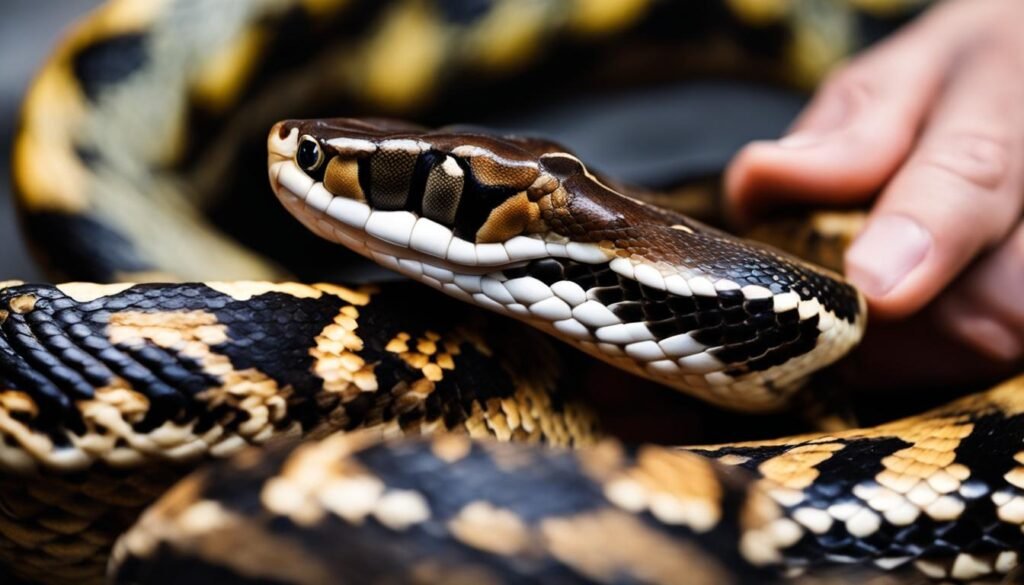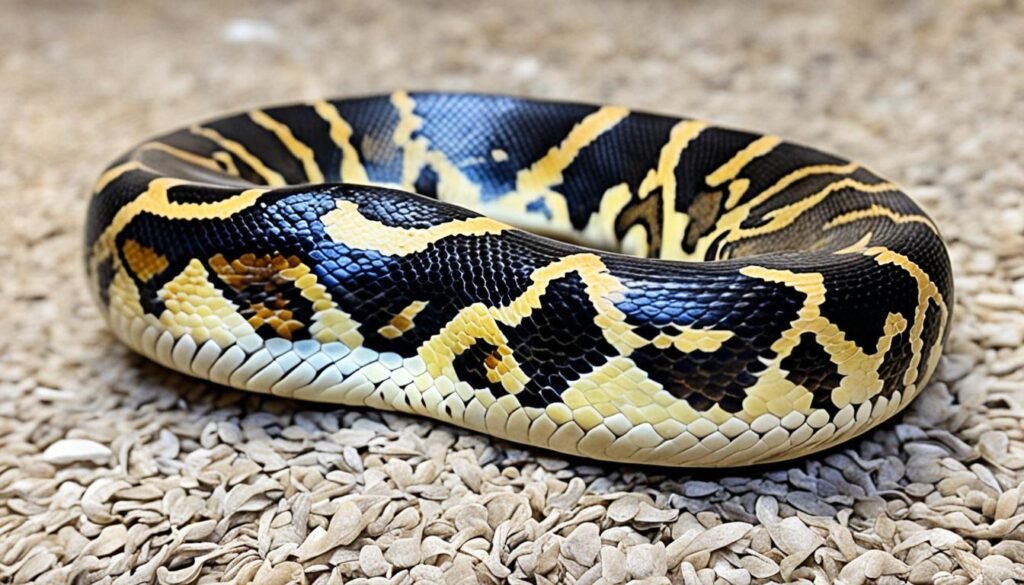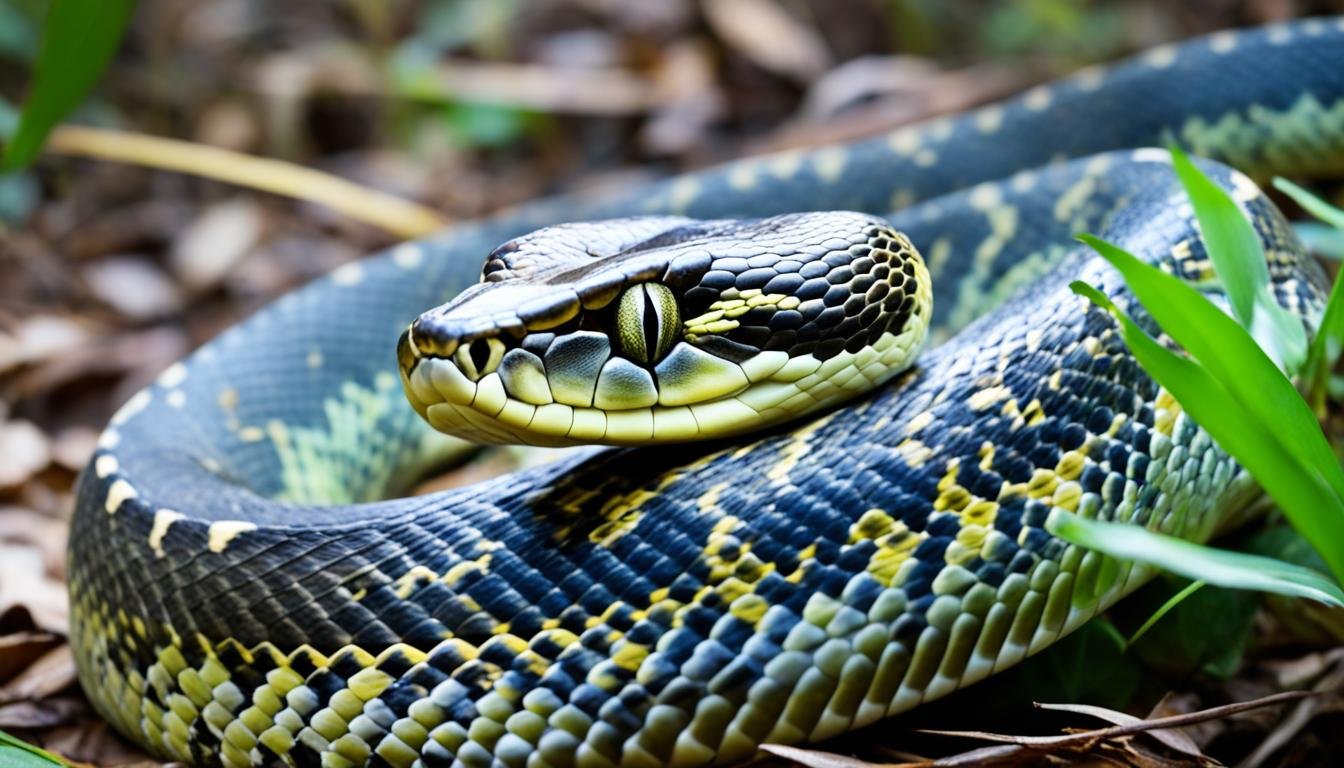Python: Did you know that ball pythons, also known as royal pythons, are one of the most popular pet snakes around the world? Their docile nature and manageable size make them a favorite among snake enthusiasts and reptile owners. However, to provide these remarkable creatures with the best care, it’s crucial to understand their behavior and specific care needs.
Key Takeaways:
- Ball pythons are a popular choice for pet owners due to their docile nature.
- Understanding their behavior is essential for creating a comfortable environment.
- Proper handling techniques and care are important for their well-being.
- Regular veterinary care and attention are necessary for maintaining their health.
- Owning a ball python can be a rewarding experience when given the proper care and understanding.
Basic Ball Python Behavior and Body Language
When it comes to understanding ball pythons, observing their behavior and body language is crucial. These fascinating creatures have their unique ways of communicating and reacting to different situations.
Common Behaviors
Ball pythons demonstrate several common behaviors that can help us understand their state of mind. Here are a few examples:
- Movement: When calm, ball pythons move slowly but purposefully. They may explore their surroundings, navigate obstacles, or find a cozy hiding spot.
- Tongue Flicking: While in motion, ball pythons often flick their tongues. This behavior helps them gather information about their environment by detecting scent particles in the air.
- Hunger: When hungry, ball pythons may exhibit different behaviors. Some lie motionless, ready to strike at any nearby prey, while others may slowly prowl around in search of food.
- Fear or Anxiety: When frightened, ball pythons have different responses. They may withdraw their head into an “S-coil” defensive posture, emit hissing sounds, try to flee, or roll into a tight ball to protect themselves.
While biting is rare, ball pythons can bite if they feel threatened or mistake a hand for prey. It is important to understand their body language and provide a secure and calm environment to minimize the chances of such incidents.
Ball Python Behavior Table
| Behavior | Description |
|---|---|
| Movement | Slow and purposeful when calm |
| Tongue Flicking | Flicking their tongues to gather information about the environment |
| Hunger | Alternating between lying motionless and prowling in search of prey |
| Fear or Anxiety | Withdrawing head into an “S-coil,” hissing, fleeing, or rolling into a ball |
Shedding and Biting Behavior
Ball pythons, like all other snakes, undergo regular shedding of their skin. During shedding, the old skin is replaced with a new one, allowing the snake to grow. A proper shed is characterized by the old skin coming off in one long piece. However, in some cases, sick or dehydrated snakes may have difficulties shedding and may shed in multiple pieces or fail to shed completely.
When a ball python experiences incomplete shedding, steps should be taken to assist the snake in removing the retained skin. This can be done by providing a humid environment, such as a moist hide or a shedding box, which helps soften the skin and facilitate its removal.
- Ensure the snake has access to a shallow water dish during shedding for hydration and to aid in the shedding process.
- Monitor the humidity levels in the enclosure to ensure it remains within the appropriate range. A humidity level of 50-60% is ideal.
- Offer the snake a rough surface, such as a branch or textured rock, to aid in rubbing off the old skin.
- If the retained shed is on specific body parts, consult a reptile veterinarian for guidance on how to safely remove it.
In addition to shedding, biting behavior in ball pythons can be a concern for some owners. However, it’s important to note that biting is generally rare and ball python bites are not usually painful or damaging. Biting may occur if the snake feels threatened or if it mistakes a hand for prey.
If you do get bitten by a ball python, there are a few steps you can take:
- Remain calm and avoid any sudden movements that may agitate the snake further.
- Gently try to remove the snake’s teeth from your skin, without pulling or forcing it.
- Wash the bitten area with mild soap and water to prevent infection.
- Monitor the bite for any signs of infection, such as redness, swelling, or pus. If infection occurs, seek medical attention.
It’s important to remember that ball pythons are generally docile creatures and incidents of biting are rare. With proper handling techniques and a calm approach, the likelihood of being bitten is minimal.
Handling Your Ball Pythons: Basics, Tips, and Tricks

Proper handling of ball pythons is essential for their well-being and to prevent stress. When handling a ball python, it’s important to follow a basic procedure to ensure both your safety and the snake’s comfort.
- Start by gently touching the snake’s back. This helps avoid startling the snake and allows it to become aware of your presence.
- Lift the snake quickly and decisively. This minimizes the snake’s stress and gives it a sense of security.
- Allow the snake to crawl freely on your hands and arms. This gives the snake an opportunity to explore its surroundings and become comfortable with your touch.
- Gently return the snake to its habitat. Swift and gentle placement back into the enclosure helps maintain a stress-free environment for the snake.
It’s important to recognize a ball python’s body language while handling them. This allows you to gauge their comfort level and adjust your handling technique accordingly. Understanding their body language can help prevent bites or stressful situations.
For defensive ball pythons, using the “paper towel trick” or a snake hook can be beneficial. The “paper towel trick” involves draping a paper towel over the snake’s head to provide a sense of security during handling. A snake hook can be used to maneuver the snake without direct contact, particularly for defensive or nervous snakes.
Excessive handling should be avoided, as it can cause stress to the snake. It’s also important to refrain from handling a snake after it has eaten, as this can disrupt digestion and potentially lead to regurgitation.
Tips and Tricks for Ball Python Handling:
- Recognize and understand the snake’s body language. This helps you anticipate the snake’s behavior and adjust your handling technique accordingly.
- Use the “paper towel trick” or snake hook for defensive snakes. These tools can provide a sense of security for the snake and minimize stress during handling.
- Avoid excessive handling. Giving the snake time to rest and acclimate to its enclosure is crucial for its overall well-being.
- Avoid handling a snake after it has eaten. This allows the snake to properly digest its food without the risk of regurgitation.
By following these handling tips and tricks, you can ensure a positive interaction with your ball python while maintaining its well-being and minimizing stress.
Illness and Disease: Signs of a Sick Ball Python

Ensuring the health and well-being of your ball python is crucial for its longevity as a pet. Like any living creature, ball pythons can experience various health problems that require prompt attention. Recognizing the signs of illness and disease is key to providing the necessary care. Here are some common health issues that can affect ball pythons:
Respiratory Infections:
Respiratory infections are particularly common in ball pythons, especially those originating from tropical areas. If your snake exhibits any of the following symptoms, it may be suffering from a respiratory infection:
- Blowing bubbles from the nose or mouth
- Unusual breathing sounds
- Drooling or excessive saliva
- Labored breathing
- Refusal to eat
If you observe any of these signs, it is essential to seek veterinary care promptly, as respiratory infections can be serious if left untreated.
Obesity:
Obesity is another health issue that can affect ball pythons. Overfeeding or feeding inappropriate prey items can lead to excessive weight gain. It is important to maintain your snake at the proper body weight to prevent obesity-related health problems. Regularly monitor their weight and adjust their feeding schedule accordingly to keep them healthy.
Other Common Health Issues:
| Health Issue | Signs and Symptoms |
|---|---|
| Skin Problems | Unusual scales, discoloration, blisters, or sores |
| Mouth Rot | Swollen, red, or bleeding gums, excessive salivation |
| External Parasites | Mites or ticks on the snake’s skin |
| Constipation | Lack of bowel movement, difficulty passing stool |
Regular visits to a reptile veterinarian are recommended to prevent and detect these conditions early on. A trained professional can provide appropriate treatment and advice tailored to your snake’s specific needs.
It is important to prioritize your ball python’s health and promptly address any signs of illness or discomfort. Regular monitoring, proper husbandry practices, and veterinary care are essential for maintaining a healthy and thriving ball python.
Housing, Temperature, and Humidity Recommendations
When it comes to housing your ball python, providing the right environment is essential for their health and well-being. A relatively large enclosure, escape-proof and designed specifically for ball pythons, is necessary to ensure their safety. This enclosure should have hiding spots where your snake can retreat to feel secure. Fresh water should always be available, and the substrates used should be appropriate for the snake’s needs.
Temperature plays a crucial role in the overall health of ball pythons. To maintain the ideal temperature gradient, the ambient temperature inside the enclosure during the day should be between 80-85°F (26-29°C). A specific basking area should also be provided, with a temperature ranging from 90-92°F (32-33°C). This allows the snake to regulate its body temperature by moving between warm and cool areas.
Proper humidity levels are equally important for the well-being of ball pythons. The recommended humidity range is between 60-80%. Maintaining the right humidity prevents dehydration and aids in shedding. To maintain the desired humidity, misting the enclosure regularly or using a humidifier can be beneficial.
It is crucial to ensure proper heating and lighting for your ball python’s enclosure. Use thermostats and heating devices designed specifically for reptiles to provide consistent and safe heat sources. A full-spectrum light or a UVB bulb is not necessary for ball pythons, as they are primarily nocturnal.
Keeping the enclosure clean is essential for the health of your ball python. Regularly remove feces and shed skin, and clean the water bowl to prevent bacterial growth. A clean and hygienic enclosure reduces the risk of disease and helps maintain a healthy environment for your snake.
Remember, ball pythons should always be housed individually, as they are solitary animals. Housing them together can cause stress, fights, and potential injuries.
Recommended Housing, Temperature, and Humidity for Ball Pythons:
| Aspect | Recommendation |
|---|---|
| Enclosure Size | Relatively large, escape-proof enclosure |
| Hiding Spots | Provide multiple hiding spots for security |
| Water | Ensure fresh water is always available |
| Temperature | Ambient: 80-85°F (26-29°C) Basking: 90-92°F (32-33°C) |
| Humidity | 60-80% humidity level |
| Heating and Lighting | Use reptile-specific heating devices and thermostats Full spectrum or UVB lighting not necessary |
| Cleanliness | Regularly remove waste and shed skin, clean water bowl |
| Housing Multiple Pythons | Absolutely not recommended. Ball pythons are solitary animals. |
Understanding Ball Python Temperament
Ball pythons are known for their docile and easy-to-handle nature. Their temperament can be influenced by various factors, including genetics, handling, socialization, and overall health. Understanding the temperament of ball pythons is essential for establishing a positive owner-snake relationship.
Generally, ball pythons are gentle and content spending most of their time hiding or sleeping. They prefer a calm and peaceful environment, where they feel safe and secure. Quick movements or sudden disturbances can startle them, so handling should be done gently and calmly.
When handling a ball python, it is important to support its entire body and avoid applying excessive force or pressure. This ensures the snake feels secure and prevents any potential injuries. By approaching the snake with patience and respect, you can build trust and establish a bond over time.
Bonding with a ball python takes time and patience. Each snake has its own unique personality, and it will respond to interactions differently. Some ball pythons may be more outgoing and curious, while others may be more reserved and shy. It is important to observe and understand their individual tendencies and preferences.
Regular and positive handling sessions can help ball pythons become more accustomed to human interaction and reduce any potential stress or anxiety. However, it is essential to respect the snake’s boundaries and never force it into uncomfortable situations.
By providing a calm and secure environment, handling with care and respect, and understanding their individual personalities, ball python owners can establish a strong bond with their snakes. This positive owner-snake relationship contributes to the overall well-being and contentment of these fascinating reptiles.
Care Tips for Ball Python Owners
Owning a ball python requires proper care and attention. Here are some tips to ensure the well-being and happiness of your ball python:
- Buy from a reputable breeder: When considering a ball python, choose a breeder who is known for their ethical practices and healthy snakes.
- Take the snake for a health exam: Shortly after bringing your ball python home, schedule a visit to a reptile veterinarian. This will help ensure that your snake is in good health and free from parasites or infections.
- Provide appropriate heat and lighting: Ball pythons require a warm environment to thrive. Use a heat pad or a heating lamp to maintain the recommended temperature range of 80-85°F during the day and provide a basking spot of 90-92°F.
- Feed the snake the right prey items: Ball pythons are carnivores and eat a diet consisting of rodents. Ensure that you are offering the correct prey size in accordance with your snake’s age and size.
- Maintain cleanliness in the enclosure: Regularly clean and sanitize the enclosure to prevent the buildup of bacteria and parasites. Replace substrate, water, and hiding spots as needed.
- Create a comfortable and stimulating environment: Provide a variety of hiding spots and branches for your ball python to explore and feel secure. Ensure a constant supply of fresh and clean water.
- Schedule regular veterinary check-ups: Regular visits to a reptile veterinarian are essential for preventive care and early detection of any health issues.
By following these care tips, you can ensure that your ball python thrives in its captivity and enjoys a long and healthy life.
| Tip | Description |
|---|---|
| Buy from a reputable breeder | Ensure the snake’s health and genetic lineage |
| Take the snake for a health exam | Identify and address any health issues early on |
| Provide appropriate heat and lighting | Maintain optimal temperature gradients |
| Feed the snake the right prey items | Ensure a balanced and appropriate diet |
| Maintain cleanliness in the enclosure | Prevent the growth of bacteria and parasites |
| Create a comfortable and stimulating environment | Offer hiding spots and stimuli for mental enrichment |
| Schedule regular veterinary check-ups | Monitor the snake’s health and well-being |
Conclusion
Understanding Python snake behavior and providing proper care are essential for anyone considering owning a ball python as a pet. These docile creatures require specific temperature and humidity levels to thrive and should be given a suitable environment to live in. Additionally, regular veterinary care and attention to their behavior and health are crucial for long-term ownership.
When the necessary care and understanding are in place, owning a ball python can be a highly rewarding experience. These beautiful snakes can make fascinating and low-maintenance companions, bringing intrigue and beauty into your life. By creating an environment that meets their needs and handling them with care and respect, you can ensure a happy and healthy life for your python snake.
Remember to provide hiding spots, fresh water, and appropriate heating and lighting in their enclosure. Furthermore, feeding them the right prey items and maintaining cleanliness are integral to their well-being. Regular check-ups with a reptile veterinarian are strongly recommended to detect any health issues early on and to ensure the snake remains healthy and content.
FAQ
What is the behavior of a ball python?
How do ball pythons shed their skin?
How should I handle a ball python?
What health problems can ball pythons experience?
What are the housing requirements for ball pythons?
What is the temperament of a ball python?
What are some care tips for ball python owners?
References
| Organization Name | URL |
| International Reptile Conservation Foundation (IRCF) | https://www.ircf.org/ |
| Herpetological Conservation International | https://herpconservation.com/index.html |
| Society for the Study of Amphibians and Reptiles (SSAR) | https://ssarherps.org/about-ssar/ |

